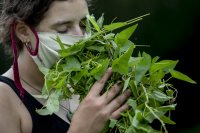
Bates community aids Lewiston High School science fair
Seventeen Lewiston High School students were honored for their work on 13 projects in the high school’s fifth annual Science Fair, held May 6.
Medals, plaques and cash awards were given to creators of outstanding science projects at the high school’s “Night of Excellence” last Tuesday, June 1.
The high school presents the annual fair with assistance from Bates College in the forms of student coordinators engaged by the college’s Center for Service-Learning, support from a science education grant funded by the Howard Hughes Medical Institute, and the participation of Bates students, staff and faculty among the judges.
“Without Bates, the fair would not be nearly as successful,” said Donald King, head of the high school’s science team. Typically, more than 450 students take part in the fair.
For their study of the capillary effect in carnations, ninth-graders Maria Delcourt and Ashley Stuart earned “Best of Fair” honors. “It was interesting to learn about the science in simple things, like flowers,” Stuart said.
First prize for the ninth-grade category went to Matt Gutshell, who explored the properties of sound passing through chambers of varied size. Second place in the ninth grade went to Tim Gilbert, third to Rachel Spilecki, and honorable mention to Ken Roy.
In the 10th grade, Andrea Lama won first place for her investigation of chlorine’s effects on plant life. Matt Bouchard and Jacob Chaloux shared second place, Mina Moore and Sarah Peters third, and honorable mention went to Thomas Robataille.
In the combined category for 11th and 12th grades, Nathaniel Jillette earned the top honor for his examination of animal requirements for light. Kelsey Varney and Sam Leeman earned second place, Ally St. Pierre and Becky Boyle took third, and Tracy Bradley was the honorable-mention recipient. All ninth- and 10th-graders at the high school are required to do a science project, and upper-class students take part as required in specific courses.
The fair is designed in part to introduce students not only to the information and skills specific to the problems their projects address but, more importantly, to the rigors of the scientific method.
The yearlong science fair project “really gives the students a chance to understand the experimental method at a deeper level, to be creative and to pick up a sense of what it takes to complete a long-term project,” said Gabrielle Voeller, of Denver, a Bates sophomore who served as this year’s science fair coordinator.
“It brings out a new kind of thinking, where one concept is worked on the entire year and the student has a chance to really develop ideas.”
The Bates students who help judge the fair also get an educational benefit, especially those studying science and education. “Their experiences at the fair support and challenge what they think they know and understand,” said Sue Martin, of the Center for Service-Learning.


